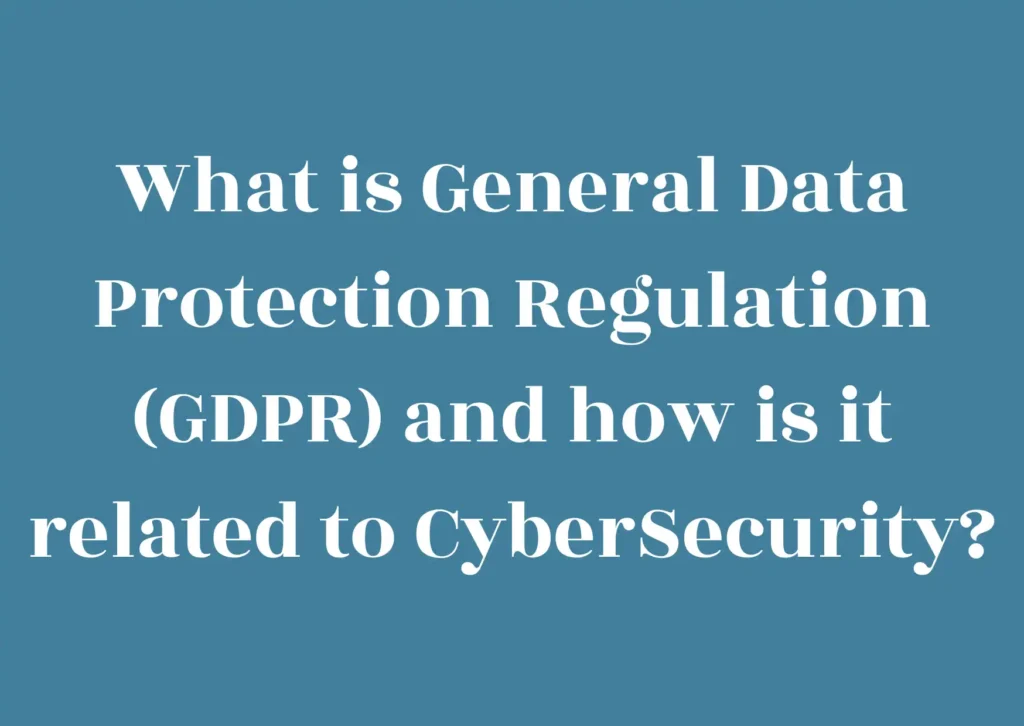The General Data Protection Regulation (GDPR) is a comprehensive data privacy and protection law enacted by the European Union in 2016 and effective since May 25, 2018. It governs how organizations within and outside the EU handle the personal data of EU residents. The GDPR aims to give individuals greater control over their personal data while ensuring businesses process and protect this data responsibly.
In today’s digital world, data is one of the most valuable assets organizations hold. With increasing cyber threats and growing concerns about privacy, protecting personal data has become a critical priority. This is where the General Data Protection Regulation (GDPR), a landmark data privacy regulation introduced by the European Union, plays a vital role. Not only does GDPR set strict standards for data privacy and handling, but it also directly influences how organizations approach cybersecurity.
This blog post explores what GDPR is, its core principles, and why it is deeply intertwined with cybersecurity in business operations worldwide.
Also Read:
The Ultimate Guide to Identity and Access Management (IAM) Tools in 2025
Cloud Principles and Design – Foundation of Cloud Computing Certification and Its Relation to CompTIA Cloud+
Mastering the CompTIA Cloud Essentials+ (CLO-002): Complete Guide to Key Chapters, Cloud Strategies, and Career Benefits

What is General Data Protection Regulation (GDPR) and how is it related to CyberSecurity?
Key Aspects of GDPR:
- Applies to any organization worldwide that collects or processes the personal data of EU residents.
- Defines personal data broadly, including names, identification numbers, location data, online identifiers like IP addresses, and biometric data.
- Requires organizations to obtain explicit consent from individuals for data processing.
- Mandates transparency about how personal data is collected, used, and protected.
- Requires timely breach notifications to authorities and affected individuals.
- Includes rights for individuals to access, correct, delete their data, and restrict or object to processing.
- Introduces stringent penalties for non-compliance—fines up to 20 million euros or 4% of global turnover, whichever is higher.
Understanding GDPR: The Basics
The General Data Protection Regulation (GDPR) is a regulation enacted by the European Union in 2016 and enforced starting May 25, 2018. It replaces the earlier Data Protection Directive and has become the gold standard for data privacy laws globally.
What Does GDPR Regulate?
GDPR governs the processing of personal data belonging to individuals (referred to as data subjects) in the European Union. Personal data under GDPR is broadly defined and includes anything that can identify a person directly or indirectly, such as:
- Names
- Email addresses
- IP addresses
- Location data
- Biometric information
- Health records
Who Does GDPR Affect?
GDPR applies to:
- Any organization operating within the EU.
- Any organization outside the EU that offers goods, services, or monitors behavior of EU residents.
Key Objectives of GDPR
- Empower individuals with control over their personal data.
- Harmonize data privacy laws across Europe.
- Ensure transparency in data handling.
- Protect personal data from misuse and breaches.
- Impose strict penalties for non-compliance.
Core Principles of GDPR
GDPR sets out several fundamental principles that shape data protection practices:
- Lawfulness, Fairness, and Transparency:
Personal data must be processed lawfully, fairly, and transparently. - Purpose Limitation:
Data should be collected for specified, explicit, and legitimate purposes only. - Data Minimization:
Only data necessary for the intended purpose should be collected. - Accuracy:
Organizations must keep personal data accurate and up to date. - Storage Limitation:
Personal data should not be retained longer than necessary. - Integrity and Confidentiality:
Data must be securely processed to protect against unauthorized or unlawful access, loss, or damage. - Accountability:
Data controllers are responsible for and must demonstrate compliance with GDPR.
Relation of GDPR to Cybersecurity:
GDPR and cybersecurity are deeply intertwined because protecting personal data demands strong cybersecurity measures. To comply, organizations must implement technical and organizational safeguards to prevent unauthorized access, data breaches, and data loss. This includes encryption, access controls, identity management, secure authentication, and incident response capabilities.
In essence, GDPR drives organizations to strengthen their cybersecurity posture by imposing legal requirements on data protection, breach detection, and privacy by design principles. Failing to meet these cybersecurity standards under GDPR can result in severe legal and financial consequences.
Thus, GDPR acts as both a privacy framework and a cybersecurity mandate, compelling organizations to safeguard personal data throughout its lifecycle.
If you want, I can provide a more detailed explanation or examples of GDPR’s cybersecurity requirements.
The General Data Protection Regulation (GDPR) has a significant impact on cybersecurity practices within organizations, especially those handling personal data of EU residents. Here’s how GDPR shapes and strengthens cybersecurity:
1. Protecting Data Requires Robust Cybersecurity
At the heart of GDPR is the protection of personal data from unauthorized access, disclosure, alteration, and destruction. This demand makes cybersecurity practices such as encryption, firewalls, secure authentication, and access controls essential to safeguard data.
2. Mandates Technical and Organizational Measures
GDPR requires organizations to implement “appropriate technical and organizational measures” based on risk. This includes:
- Secure user authentication systems.
- Network and endpoint security solutions.
- Data encryption in transit and at rest.
- Incident detection and response mechanisms.
3. Breach Notification Requirements
GDPR obliges organizations to notify data protection authorities within 72 hours of discovering a personal data breach, and in some cases, notify the individuals affected. This necessitates effective cybersecurity monitoring tools and breach response plans.
4. Encourages Privacy by Design and Default
Cybersecurity and data privacy must be embedded into system design and development from the beginning. This means building systems with strong security controls, minimal data collection, and secure defaults — a core cybersecurity practice.
5. Requires Access Controls and IAM
Managing who can access personal data is fundamental. Identity and Access Management (IAM) tools — including multi-factor authentication (MFA), privileged access management (PAM), and identity governance (IGA) — help enforce GDPR’s strict access requirements.
6. Increases Focus on Audit and Accountability
GDPR’s accountability principle requires maintaining detailed logs and audit trails of data processing activities. Cybersecurity tools that monitor access and changes to data records support these compliance needs.
The Business Impact of GDPR on Cybersecurity Practices
Enhanced Security Investments
Since GDPR’s enforcement, organizations worldwide have increased investments in cybersecurity infrastructure to avoid penalties and protect reputation. Businesses now prioritize:
- Strong encryption protocols.
- Identity management and access controls.
- Advanced threat detection and response.
- Data loss prevention solutions.
Process and Policy Revisions
GDPR’s requirements lead to updates in organizational policies regarding data handling, security awareness training, and incident management — all essential elements of a mature cybersecurity program.
Cross-Disciplinary Collaboration
Data privacy and cybersecurity teams work closely to ensure integrated strategies that satisfy both legal compliance and security objectives.
Risk Management Approach
GDPR encourages organizations to adopt risk-based cybersecurity measures tailored to the sensitivity of data and threat landscape — moving away from one-size-fits-all solutions.
Consequences of Non-Compliance with GDPR
Failure to comply with GDPR can result in:
- Fines up to €20 million or 4% of global yearly turnover, whichever is higher.
- Legal actions from data subjects.
- Loss of customer trust and severe reputational damage.
Several high-profile breaches and penalties since GDPR’s implementation underscore the critical need to strengthen cybersecurity as a shield for data privacy.
Conclusion: Why GDPR and Cybersecurity Go Hand in Hand
GDPR is far more than just a data privacy law; it is a catalyst that has transformed how organizations approach cybersecurity. By enforcing stringent data protection requirements, GDPR compels businesses to upgrade their security technologies, embed privacy by design, maintain rigorous access controls, and prepare proactive breach response mechanisms.
For any organization handling EU residents’ data—or looking to build trust in a data-driven world—understanding GDPR and enhancing cybersecurity practices are indispensable parts of a modern risk management strategy.
Stay Secure, Stay Compliant!
Implementing robust cybersecurity aligned with GDPR is not just about avoiding fines — it’s about safeguarding your customers, business reputation, and future growth.
Also Read:
The Ultimate Guide to Identity and Access Management (IAM) Tools in 2025
Cloud Principles and Design – Foundation of Cloud Computing Certification and Its Relation to CompTIA Cloud+
Mastering the CompTIA Cloud Essentials+ (CLO-002): Complete Guide to Key Chapters, Cloud Strategies, and Career Benefits
Techno Tips Learning YouTube Channel: https://www.youtube.com/@techno_tips_learning



